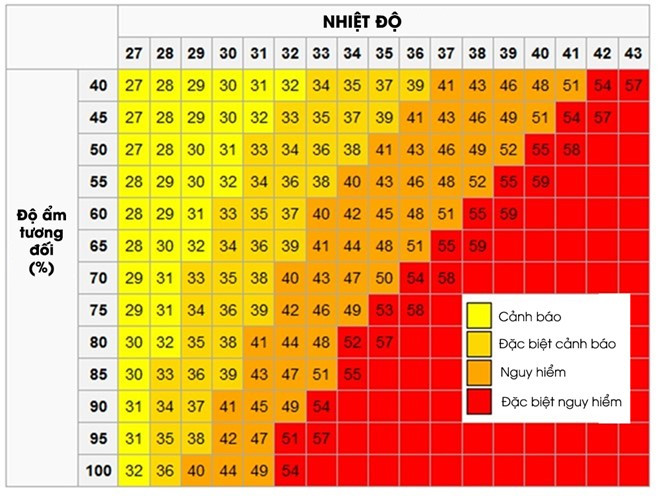Danger when temperatures rise
Overheating can damage the brain and some other parts of the body, even, leading to death.
Summer is likely to make you uncomfortable, even damage to your health, especially in hot days with high humidity. The human body is not made to withstand high temperatures. Overheating can damage the brain and some other organs, leading to death.
So how do you know if the heat level is dangerous?
To provide heat warnings, the US Weather Service - Weather Service uses the HI - heat index . In fact, the body's hot or cold feeling is decided simultaneously by both factors: temperature and humidity.
When the body gets hot, it will sweat . This is considered the natural cooling system of humans. When sweat evaporates, it carries heat on the surface of the body and helps reduce heat. However, high air humidity will reduce the body's ability to sweat. Therefore, the combination of hot sun and high humidity is a great danger to people.

The heat index table shows the correlation between temperature - humidity and danger warning level for humans.(Photo: SRH).
However, few people know that the value of the above heat index board is measured in the shade. If in the direct sunlight, the temperature difference can be up to 9-10 degrees Celsius. As shown in the table below, the outdoor temperature above 41 degrees Celsius has started to be set at the danger warning level with human.

Outdoor temperature and impact on people.(Photo: SRH).
Heat diseases
Hot sun can make us sick. However, the document of the US Department of Health and Human Services confirms that the elderly, babies, children, people with health problems and obese people are more vulnerable.
Here are some diseases that can occur during hot weather:
- Fainting due to heat : sudden shock and fainting happens when standing long in the sun.Fainting from heat is treated by placing the victim in a position in a cool environment and drinking water.
- Heat cramps : are painful spasms of large muscle groups of the body, usually the calves, thighs and shoulders, that occur during or shortly after exercise in the hot air.Cramps occur when the body is rehydrated but not adequately supplemented with salt, resulting in decreased blood sodium in the muscles.The best way to treat heat cramps is to compensate for the electrolytes and saline for the body.
- Heat edema : mild swelling of the feet and ankles.The solution is to lie down and set foot high.
- Heat loss: a warning that the body cannot cool itself.You may feel thirsty, tired, dizzy, vomiting, minimal mental changes.In addition, the body may sweat.Although the body temperature is normal, the friend is cold.Some people may also have a fast pulse.The solution is to take the patient to rest in a cool place, drink plenty of water.If not supported, it must be taken to an emergency medical facility.
- Heat shock : also known as heat stroke , can be life-threatening.Some signs of heat shock are lethargy, body temperature is more than 40 degrees, abnormal behavior, rapid pulse, no sweating, . At this time, it is necessary to bring patients to medical facilities sacrifice.

Hot sun can cause serious consequences for the body.(Photo: wiseGeek).
Avoid heat
The US Department of Health and Human Services recommends, the simplest way to reduce the risk of heat illness is to avoid sun in shady areas. For those who are forced to go to the streets or work outdoors, the following principles need to be kept in mind: careful body shielding such as wearing hats, sun-protective shirts, cotton wear, and comfort; Bring water to continuously replenish your body, especially filtered water. Avoid alcoholic drinks or coffee.
For those staying indoors, window shielding should be avoided, not using a stove on a sunny day.
During the summer, regular bathing or washing is not only good for hygiene but also a useful way to help your body cope with the heat.
- Bad scenario in 2060
- Global temperatures rise, what will happen?
- Humans push the Earth's climate to the brink of danger
- Sea level will rise by 0.9m in the next 80 years, millions of people will be displaced
- Seawater affects global temperatures
- Global temperatures rise to an alarming level
- The scary of climate change: The coldest animals cannot live anymore
- Dispersed or extinct?
- What susceptible to heat?
- Ice in the Alps can disappear by 2100
- Spring can come earlier with North American forests, increasing CO2 absorption
- Why is red related to danger? Explain you never heard of it before
 Green tea cleans teeth better than mouthwash?
Green tea cleans teeth better than mouthwash? Death kiss: This is why you should not let anyone kiss your baby's lips
Death kiss: This is why you should not let anyone kiss your baby's lips What is salmonellosis?
What is salmonellosis? Caution should be exercised when using aloe vera through eating and drinking
Caution should be exercised when using aloe vera through eating and drinking Electricity-Free Cooling: The Ideal Approach to Climate Control?
Electricity-Free Cooling: The Ideal Approach to Climate Control?  Why is the Earth's core still hot after billions of years?
Why is the Earth's core still hot after billions of years?  World's largest CO2 heat pump can heat 25,000 homes
World's largest CO2 heat pump can heat 25,000 homes  Should you try infrared heat therapy for health care?
Should you try infrared heat therapy for health care?  World's largest heat pump in Finland
World's largest heat pump in Finland  Solar reactor turns water into hydrogen
Solar reactor turns water into hydrogen 